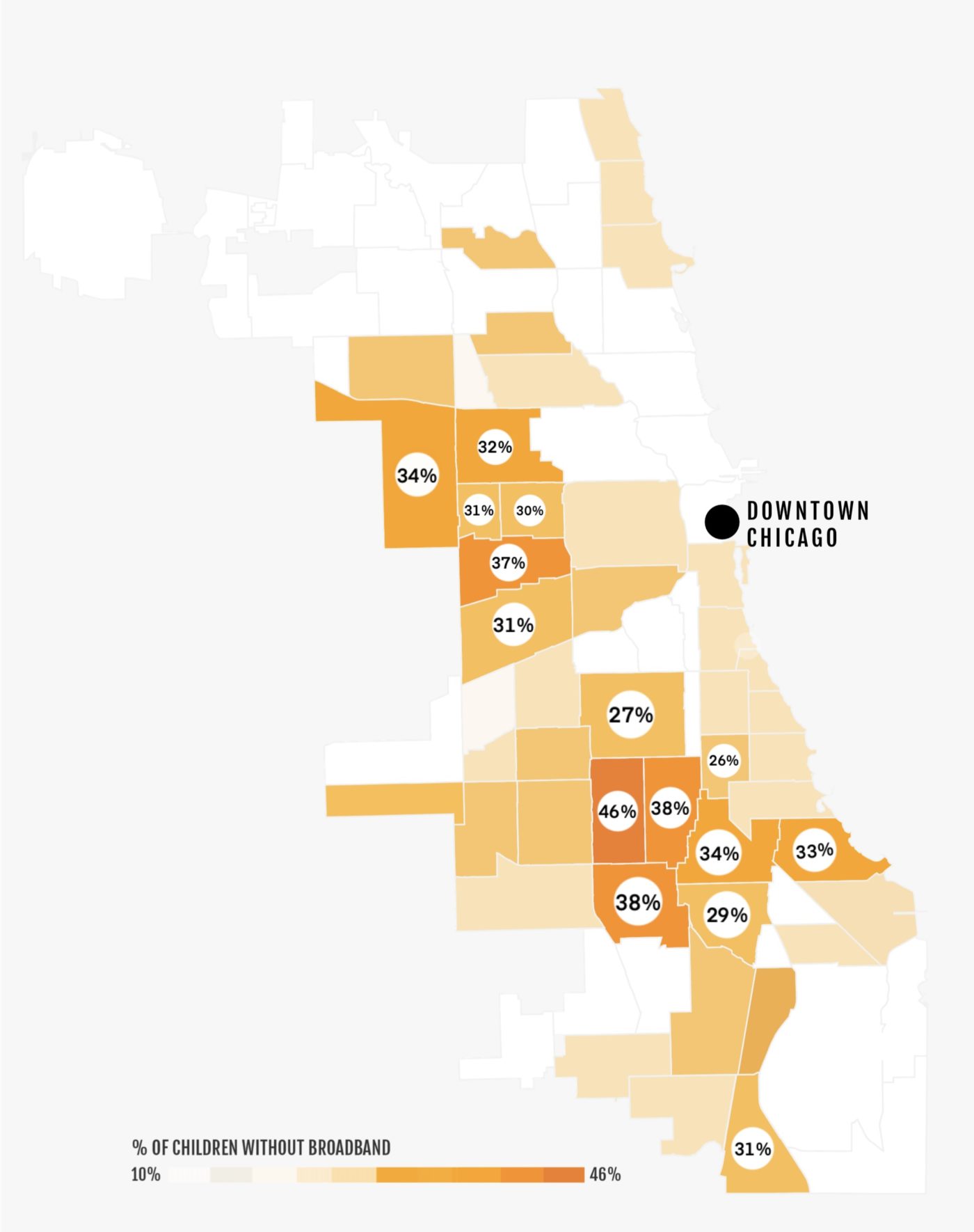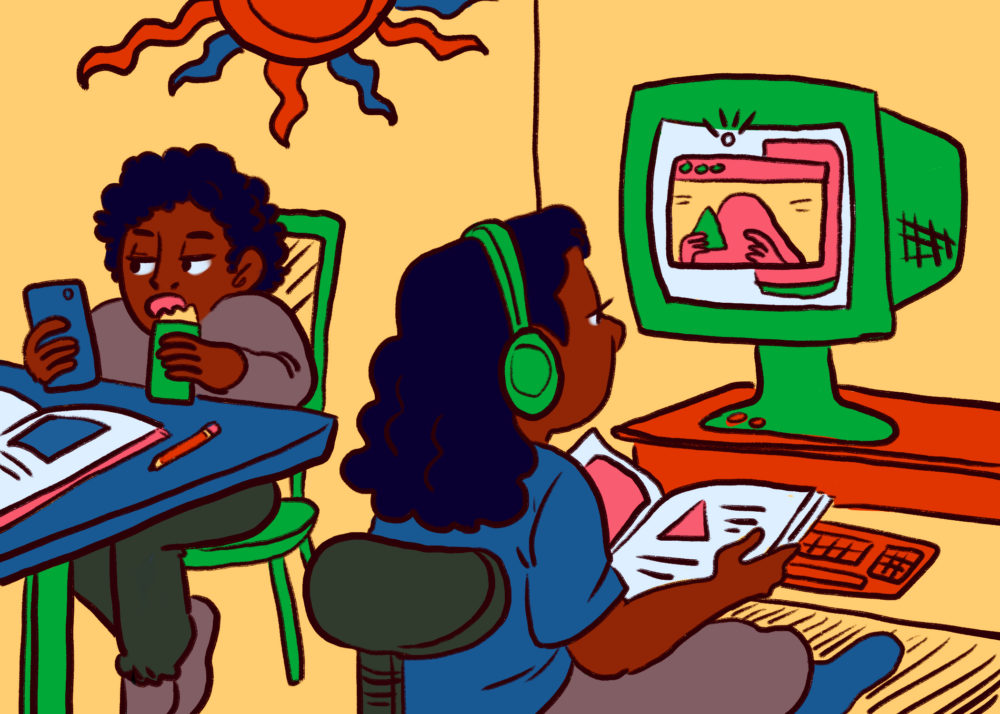South Side Weekly is gauging interest in a town hall event where residents can share how they’ve been affected by a lack of reliable internet access. If you are interested in attending the town hall or discussing it with the Weekly, please contact NaBeela Washington at beelawashington@gmail.com or (312) 547-1088, or fill out the form at bit.ly/DigitalDesertTownHall.
Imagine not being able to complete schoolwork necessary to move ahead in your grade. Imagine not being able to communicate with your family and friends over Zoom, or being the last to hear about local and national news, all because you don’t have access to a stable internet connection. This is what ‘connectivity’ looks like for certain residents in Chicago. This is the impact of living in a digital desert.
Chicago residents in neighborhoods on the city’s South and West Sides have been struggling with prohibitively expensive internet costs, unreliable connections, and a lack of devices to access the web. There have been a few initiatives to address the issue, with more potentially on the way, and significant progress has been made to improve access. Still, resident testimonies make evident that more needs to be done to bridge the divide.
In 2020, Kids First Chicago, a group that works with Chicago Public Schools (CPS) to increase graduation rates, partnered with the Metropolitan Planning Council to build a report on internet infrastructure, access, and adoption among CPS students and families. According to the report, one in five children under the age of eighteen—or about 110,000 kids across the city—lack access to broadband.

Families without access to broadband were predominantly located in South and West Side neighborhoods, like Englewood, North Lawndale, and Washington Park. A further 90,000 households without kids also did not have reliable internet access.
The report suggested creating subsidy programs, expanding wifi hotspot locations, and increasing access to low-cost or free internet programs. In response, CPS created Chicago Connected, a program that subsidizes internet for eligible families at no cost. A one-year survey in 2021 found that 64,000 students across 42,000 households had been enrolled in the program. Around one in four survey respondents “reported that they did not have internet access prior to Chicago Connected” and that of these, nearly three in four said it was because the cost was “prohibitive.”
The report claims that the internet service providers (ISPs) in Chicago already have the infrastructure to provide reliable internet to every resident. Not everyone agrees.
20th Ward Alderperson Jeanette Taylor is working with AT&T to wire her ward—which includes most of Woodlawn and large parts of Washington Park, Englewood, and Back of the Yards—for high-speed internet, which she says is lacking. “When I was running for office, if more than five or six of us were on the internet, it would just drop. And I was paying for the best internet,” she said.
Taylor primarily communicates with residents with limited or no internet access by phone. “Sometimes it’s not even about access, it’s about the underground wiring.”
“It’s frustrating how much of an obstacle it is to get consistent, strong, and affordable internet in Washington Park,” said Maya Tatum-Lattimore, a neighborhood resident. “We pay so much and still can’t manage to support two people, in a two-bedroom apartment working from home.”
Chamara Moore, also in Washington Park, faces the same problem. “It’s a joke in our neighborhood…even though we see an Xfinity technician in the area, every month, they’ve told us numerous times there’s nothing they can do to improve the internet for our building,” she said. “Extenders don’t work. Outages are constant. Even our local coffee shops have spotty connections, but if I drive a bit to a white neighborhood, I never have any issue.”
In addition to being a barrier for remote learning and work, a lack of internet access has been linked to higher rates of mortality from COVID-19. A study published earlier this month found that even when controlling for other risk factors like socioeconomic status, age, and disability, a lack of internet access was one of the strongest factors associated with increased deaths from the virus.
Recognizing the source of the disparities in internet infrastructure and access seems key to ensuring everyone gets to connect reliably. Last year, a team of researchers from the University of Chicago were awarded a $1.2 million grant from data.org to assemble stories from residents and aggregate data to strengthen insights on the digital divide and what infrastructure, resources, and planning are needed to alleviate the disparities. It’s unclear what’s been done so far.
In the meantime, local knowledge has helped address some gaps in access. Woodlawn nonprofit Sunshine Enterprises began teaching its entrepreneurship classes online during the pandemic and partnered with T-Mobile and Comcast to institute a Digital Access Program (DAP) to loan out hot spots and laptops. “A lot of people just don’t have access to anything,” noted program coordinator and Woodlawn resident Ashley James.
Community education about the gaps in digital access has proven essential to the success of Sunshine’s program. To date, 156 small business owners, mostly in Woodlawn and South Shore, received Chromebooks or relied on hot spots to complete coursework online.
Even with better information about the digital divide, the City will need to marshall a significant amount of time and resources to address the problem and prioritize the South and West Sides. “Black, brown, and poor people are not prioritized in the City of Chicago,” said Taylor. “It’s simple. There has to be a political will to make sure that the city is balanced.”
“It’s clear cable and internet is yet another racialized difference in our city infrastructure,” said Moore. “It’s made the extra remote work in the pandemic almost impossible.”
Access to the internet is a national issue. According to the Pew Research Center, ninety-three percent of all U.S. adults used the internet in 2021, but that number dropped to eighty-six percent for Americans making less than $30,000, and further down to seventy-five percent for Americans aged sixty-five or older. The $1.2 trillion Infrastructure Investment and Jobs Act, passed by Congress and signed into law by President Joe Biden last November, set aside $65 billion to build out broadband infrastructure for the thirty million Americans without reliable internet access. Much of that money will be funneled into grants for each state later this year.
There may also be state funding available to tackle the issue in the coming years. Governor J.B. Pritzker’s 2019 Rebuild Illinois capital plan set aside $400 million for Connect Illinois, a state matching grant program that aims to expand access to reliable, high-speed internet service statewide. So far, Cook County has received just over $1 million in grants, all of which have been used to shore up broadband infrastructure in the south suburbs. Up to $350 million is up for grabs in this year’s funding round, some of which may make its way to Chicago.
Senior Planet, an affiliate of the American Association of Retired Persons (AARP), is also working to address the digital divide across Illinois. At the start of the pandemic, Senior Planet launched its Aging Connected Initiative, which connected older adults with low-cost internet options. The initiative also made sure older adults struggling with connectivity, especially those living in low-density or rural areas, gained access to the Emergency Broadband Benefit (EBB)—now known as the Affordable Connectivity Program—a federal program that helps families and households struggling to afford internet service during the COVID-19 pandemic.
More recently, with the help of a $10 million grant from Google, the AARP Foundation launched Digital Skills Ready@50+, an initiative to provide technology and digital skills training to people over fifty who are living with low income.
“We are working to mitigate the perpetuating reason behind why digital deserts are so prominent among the older adult demographic,” said program coordinator Deirdre Lee. “The Aging Connected initiative helps older adults find low-cost internet in their area and free Senior Planet programs can help ensure that seniors are able to integrate digital skills into their lives,” she added. The program will be coming to Illinois this year, which you can learn more about here.
These programs could help create access to affordable internet services and reliable infrastructure from ISPs that help close the digital divide, a growing gap between those with access to the internet and those without—often poor, rural, elderly, and other underprivileged communities. “There is a tale of two cities here with the have and have nots and usually the have nots look like me,” said Taylor. “We’re a rich enough city to make sure that everyone has free access to the internet. Hands down.”
“It’s equity or else.”
South Side Weekly is gauging interest in a town hall event where residents can share how they’ve been affected by a lack of reliable internet access. If you are interested in attending the town hall or discussing it with the Weekly, please contact NaBeela Washington at beelawashington@gmail.com or (312) 547-1088, or fill out the form at bit.ly/DigitalDesertTownHall
Benjamin Nober contributed reporting.
NaBeela Washington is an Alabama-raised poet, editor, and budding art collector. Learn more at nabeelawashington.com

